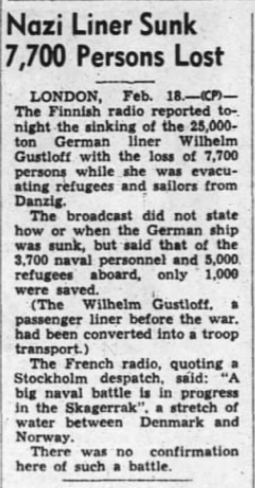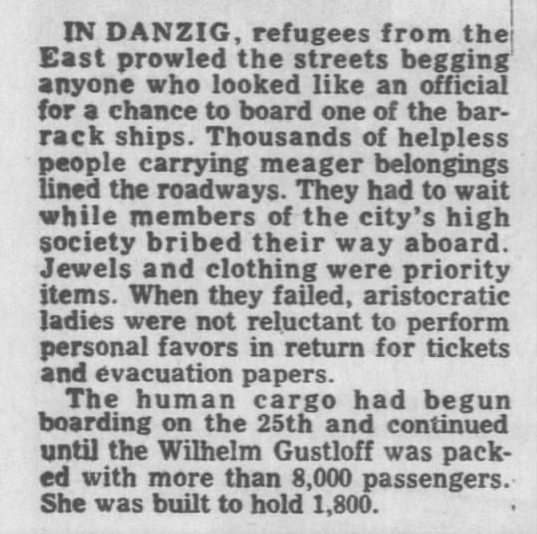On January 30, 1945, the greatest maritime disaster in history occurred when the MV Wilhelm Gustloff, a German luxury liner turned military transport ship sank in the Baltic Sea after being torpedoed by a Russian submarine. The sinking ship resulted in the loss of an estimated 9,300 victims, including 5,000 children. Those on board included 9,000 civilians fleeing an advancing Red Army, German soldiers, and the crew. The fatalities were six times that of the Titanic.
Three months earlier, in October 1944, the Russian Army broke through German defense lines in East Prussia, inflicting atrocities on German civilians. Fearing the approaching army, thousands began to flee west. The temperatures were freezing, and many suffered frostbite, exposure, and starvation. In January 1945, the refugees converged on the docks at Gotenhafen (today Gdynia, Poland) and tried desperately to obtain passage on transport ships appropriated by German officials. The Gustloff, which launched in 1937 as a luxury liner, was now transporting soldiers to western Germany but allowed refugees to board as well. The ship was built to accommodate roughly 1,900 people but quickly filled beyond capacity as some 10,000 boarded the ship. Shortly after noon, the ship set sail.
Just beyond the Gulf of Danzig, the Russian submarine S-13 under the command of Capt. Alexander Marinesko patrolled the waters. On the evening of January 30th, the sub surfaced and spotted the Gustloff sailing in deep waters to avoid the heavily mined area closer to the coast. Suspecting the ship held German combatants, Marinesko decided to attack. He maneuvered S-13 alongside the ship until shortly after 9:00 p.m., when he ordered the launching of three torpedoes. All three impacted the ship’s port side.
The torpedoes exploded and the initial impact likely killed hundreds. Startled passengers clambered to get up on deck and in the panic, some were trampled, while others drowned as water flooded in. As the Gustloff began to list, panicked passengers found the davits holding the lifeboats in place were coated with ice and inoperable. In the chaos, young mother Irmgard Harnecker clung to her baby daughter Ingrid. Suddenly, an icy wave swept over the deck ripping the baby from her arms. Harnecker also lost her sister in the tragedy. Another young mother had given birth to a baby boy less than 24-hours earlier in the ship’s hospital. She named him Egbert Worner. When the torpedoes hit the ship, she ran up on deck holding the newborn but struggled to descend a rope ladder to a rescue vessel. A nearby soldier called out, “give it to me, you’ll get it back right away.” She handed baby Egbert to the soldier, but the lifeboat was lowered before he handed the child back. She watched the ship sink and feared her child was dead. “I was quaking,” she said. When she boarded a rescue vessel several hours later, someone placed a bundle in her arms. Her baby had been saved!
Passengers recall the horrific screams as the Gustloff sunk below the surface within an hour of the torpedoes’ impact. Those in the sea quickly succumbed to the icy water. Rescue boats arrived and picked up as many as 900 survivors, but the surface of the sea was littered with the dead. The risk of enemy submarine attacks remained and rescue efforts abandoned after one navy barge was nearly struck by two more torpedoes, missing its hull by mere inches.
The magnitude of the incident became somewhat lost in the headlines of war. World War II was months away from ending and Russia suppressed news of the disaster for another 50 years. The fate of the ship was not made public in Germany during the war and publishing tales of Germany’s hardship was prohibited in East Germany after the war. As we approach the 75th anniversary of the tragic sinking of the Wilhelm Gustloff, you can search for more news related to this maritime disaster on Newspapers.com today.
Like this post? Try one of these:
Lake Nyos Disaster: August 21, 1986




This site has had barely any updates this year except for those papers in New Mexico. This site needs to either do something or pull the plug like Newsbank did.
If you go to Newsbank they pulled the plug and told me they were as I wondered why they kept removing the payment plans. They first removed the monthly pass then the weekly pass till all their was was a single article download. Now the site receives a ‘No Internet Connection’ error period yet the newspapers individually still try to link to it and not realize it isn’t working.
For example the Fresno Bee.Newsbank is dead yet the Fresno Bee paper tries to link to it or Merced Sun or whatever it’s called.
Hi Kyle, we added more than 100 million pages of new content from numerous states in 2019 and are excited for a great year in 2020!
The list of weird gap years are so high they’d block the moon.
Kyle, why don’t you start your own company? It would put paid to the idea of a monopoly, and you could add every paper you mentioned is missing instead of complaining about it.
I have been searching for information about William Wallace McCoy or his wife Betsy McCoy.
A great author, Ruta Sepetys, researched and wrote of this sinking. Her book on it is called, “Salt to the Sea”. This is really a wonderful book. Please read it.
MH.
Thank you so much for the book reference.
Annie
We just read SALT TO THE SEA for a book discussion group. It’s great. Participants didn’t want to stop talking. SR
I will look for it! I loved the historical fiction “Dead Wake”! Similar…
I love reading these Headlines in History. You always do such a great job at giving us a small glimpse of the events that happened in either American or World history. These blog posts are sort, simple, and easy to follow. I also love how you give direct links to the newspaper clippings that you used to make the brief interpretations.
Thanks to all who write these up! I enjoy reading them when I get on my lunch break at work.
Without criticism, I was wondering if and when you might include some newspapers from Puerto Rico and Virgin Islands. The San Juan Star even, though three Spanish language ones would be better. Even though I would have to spend time translating, it would be worth the trouble, and having the search engine is the game changer vs my cranking thru microfiche reels. Thank you for your consideration.
Kent, I just asked the content team and there is nothing in the works at this moment for Puerto Rico or the Virgin Islands. They are constantly working with partners to get new content and I’ll pass along your requests.
wow, had never heard of this. horrible. thank you for the article.
I had never heard of this tragedy before. What a shame! That so many civilians were lost, and then, that the story was suppressed! And to have not been told for so many years. So many personal stories that I am sure families of those who perished, would have liked to know. Man’s inhumanity to man, is really something. And here we are, faced with another current tragedy, in the shooting down of the plane in Iran, again with civilians paying the price. Sad.
THERE WAS A WAR GOING ON, IN WAR TIME THINGS HAPPEN. REMEMBER PEARL HARBOR AND SHIPS LIKE THE INDANAPOLLIS.
Great story. My high grandmother was working aboard a merchant vessel the SS South Western torpedoed by a German u boat in the English channel 1918. Do you cover UK newspaper histories or just American?
Hi Mark, We do have some titles from the UK. I just did a quick search on “U-boat” in The Guardian (in 1918) and came up with 35 hits.
I suggest reading this
https://en.m.wikipedia.org/wiki/World_War_II_casualties_of_the_Soviet_Union
The internet has been taken over by know-it-all’s and oneupmanship. Sounds like kindergarten! What a shame.
What a timely article . . . well, in connection to a book I’m reading. It is Ruta Sepetys’ “Salt To The Sea” and is based on the story of how some of the passengers (refugees, soldiers, etc.) came to be there. I haven’t finished the story yet but have reached the point where the boat was sunk. Time Magazine called it “the forgotten tragedy that was six times deadlier than the Titanic.” I recommend it, along with the occasional tissue.
Thanks Jenny for this article.
When men decide to wage war against others, it is almost always the civilians who pay a big price, especially women and children. We’ve seen this in the past week, as the consequence of Trump’s decision to wage war against Iran – the main casualties of the Ukrainian plane being shot down were young people just starting their lives – very promising, educated young people – mostly Canadians and young Iranians in Canada on student visas. Trump tweeted a boast that no Americans were killed. Goody for him….
My father’s cousin along with her children were in line to get on the ship but couldn’t get on before it sailed. Her daughter remembers meeting another woman after both had moved to Canada — the other woman’s family was literally the next in line when they closed the boarding line. Such narrow escapes!
I had never heard of the tragedy before my cousin sent me her wartime stories a few years ago for my family history but looked it up then.
Would there be a list of passengers anywhere?
From Devastating Disasters:
Wilhelm Gustloff Disaster death toll: Unknown, as no civilian manifest existed.
That is a great find in publishing that horrific story. Thank you for doing that. I am a subscriber to Newspapers.com, keep up the good work.